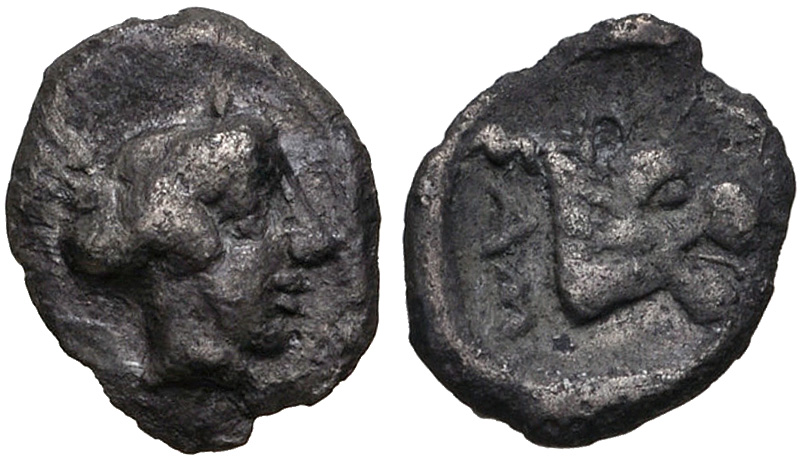Nymphaeum? (Sammas), silver, hemiobols (438-436 BCE)
From SILVER
438 BCE - 436 BCE Silver 17 kg
Description
| ObverseInscription or printing placed on the obverse.: | Head of nymph right, hair in sphendone |
| ReverseInscription or printing placed on the reverse.: | ΣAM (Greek).Head of lion right, ΣAM to left |
Mint and issuing power
| MintIdentifies the place of manufacture or issue of a numismatic object.: | Nymphaeum | Ancient regionAncient region.: | Bosporus | Modern countryModern country: Russia (Crimea) | AuthorityIdentifies the issuing power. The authority can be "pretended" when the name or the portrait of X is on the coin but he/she was not the issuing power. It can also be "uncertain" when there is no mention of X on the coin but he/she was the issuing power according to the historical sources: | Sammas (dynast of uncertain place in the Thraco-Macedonian region) |
Chronology
| FromIdentifies the initial date in a range assigned in a numismatic context. | 438 BCE | toIdentifies the final date in a range assigned in a numismatic context.. | 436 BCE | PeriodTime period of the numismatic object.: Classical 480-323 BC |
Physical description
| MetalThe physical material (usually metal) from which an object is made.: | Silver |
Median weightMedian of the weights of numismatic objects (in grams). in grams | 0.30 | DenominationTerm indicating the value of a numismatic object. Examples: tetradrachm, chalkous, denarius.: | hemiobol |
StandardStandard.: |
Image

AC100a Sammas hemiobol.jpg [1]
References
| Die study referencePublication of the study: | Stolba 19981Stolba 1998, n° 10-13 | ||
| Coin series referenceReference to coin series study: | RQEMAC2RQEMAC, n° 100a, HGC 73HGC 7, n° 16 | ||
| Coin series web referenceCoin series web references: | |||
Obverse dies distribution
| FrequencyFrequency of specimen in distribution. ᵖ | Number of obversesNumber of obverse dies. ᵖ (o) | % (o) | Number of coinsNumber of coins. (n) | % (n) | Die nameName(s) of the die(s). |
| 2 | 1 | 50 | 2 | 40 | 2 |
| 3 | 1 | 50 | 3 | 60 | 1 |
| Total | 2 of 2 | 100 | 5 of 5 | 100 |
Reverse dies distribution
no distribution is available
Quantification
| Number of obversesNumber of obverse dies. ᵖ (o) | 2 | Number of singletons (o1)The number of singleton coins. ᵖ | |
| Number of reverse diesNumber of reverse dies. (r) | 2 | Number of coinsNumber of coins. (n) | 5 |
| Coins per obverse dieNumber of coins per obverse die. (n/o) | 2.5 | Coins per reverse dieNumber of coins per reverse die. (n/r) | 2.5 |
| Reverse per obverse ratioRatio of obverse dies divided by reverse dies. (r/o) | 1 | Percentage of singletons (o1)number of coins (n) divided by the number of singletons (o1) ᵖ | % |
| Original number of dies (O) (Carter 1983 formula)The estimation of the number of coins according to Carter 1983 ᵖ | 2.79 | Coins struck if 20,000 as average productivity per dieCoins made if the average productivity for obverses (according to Carter) is 20,000. ᵖ | 55,800 |
| Original number of dies (O) (Esty 2011 formula)The estimation of the number of coins according to the singleton formula in Esty 2011 ᵖ (O) | 3.33 | Survival rate if 20,000 as average productivity per dieSurvival rate if average productivity is 20,000. ᵖ | 0.00009 |
| Coverage (o = % of O) (Esty 1984 formula)Esty 1984 - coverage (% of O) ᵖ (o = % of O) | % | Die productivity if survival rate 1/2,000Average productivity if survival rate is 1/2,000. ᵖ | 3,584.23 |
| Weight of silver (in kg) if 20,000 coins per die (O = Carter formula)Carter 1983 * Median weight * 20000 (*10 if gold or electrum) ᵖ | 17 kg <br /> 17 kg | Die productivity if survival rate 1/5,000Average productivity if survival rate is 1/5,000. ᵖ | 8,960.57 |
Remarks
Most likely one single workstation
References
- ^ Stolba, Vladimir (1998), "ΣAMMAΣ: Zur Prägung eines bosporanischen Tyrannen," in Ulrike Peter (ed.), Stephanos nomismatikos: Edith Schönert-Geiss zum 65. Geburtstag, Berlin, Akademie Verlag. p.601-611
- ^ Callataÿ, François de (2003), Recueil quantitatif des émissions monétaires archaïques et classiques, Numismatique Romaine, Wetteren, VII + 267 p.
- ^ Hoover, Oliver D. (2012), Handbook of Greek Coinages. 7. Coins of northern and Central Anatolia - Pontos, Paphlagonia, Bithynia, Phrygia, Galatia, lykaonia, and Kappadokia (with Kolchis and the Kimmerian bosporos), Lancaster, lxxxii, 352 p. : ill. ; 23 cm.